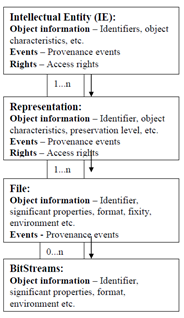The general structure and the components of AIPs are publicly described in the Rosetta AIP Data Model.
An AIP in Rosetta is identical to an intellectual entity (IE) described by an METS file (ie.xml). The METS profile is publicly accessible.
An IE can have 1-n representations, each of which consists of 1-n files. Precisely one of the representations must be the PRESERVATION MASTER. The METS structural map describes the relationships between files within a representation. The METS profile does not specify any restrictions for file formats.
Graphic: Rosetta Data Model Structure (source: Rosetta AIP Data Model)

The descriptive metadata in the METS-dmd section are recorded in Dublin Core format. Both DC Simple and DC Qualified can be used for this.
Technical, administrative and event metadata are written to the relevant amd sections of the METS file (amd-digiprov, amd-rights, amd-tech, amd-source) in the form of DNX metadata elements. The DNX schema was specified by the software manufacturer Ex Libris and is based on PREMIS, but extends the standard by further elements. DNX documentation is publicly available. Updating of DNX is managed and monitored by the Rosetta user community. Structural metadata are recorded via the METS structural map (structMap).
Additional metadata standards (MARC, Dublin Core, MODS, EAD, NISO, MIX) can be embedded in the METS file as so-called source metadata.
TIB uses the concept of the logical AIP, and saves the files, the METS and the catalogue metadata in physically separate places. The graphic below Transforming transfer information packages to SIPs and AIPs describes not only how transfer information packages are transformed to pre-ingest SIPs, post-ingest SIPs and AIPs, but also the structure of a logical AIP at TIB.
The METS file contains:
- The descriptive, technical, structural and administrative metadata for an IE
- Information about representations, and references to the storage paths of the files belonging to the relevant representation
- The reference to the internal-system ID under which the XML file is stored together with the catalogue metadata.